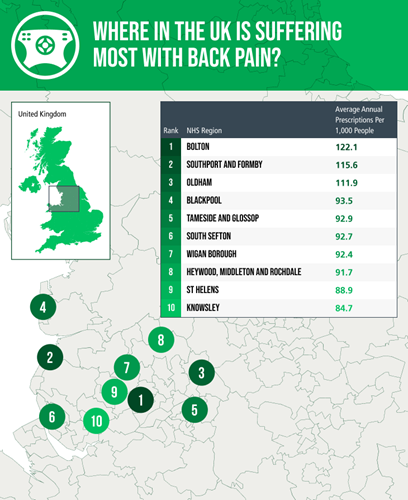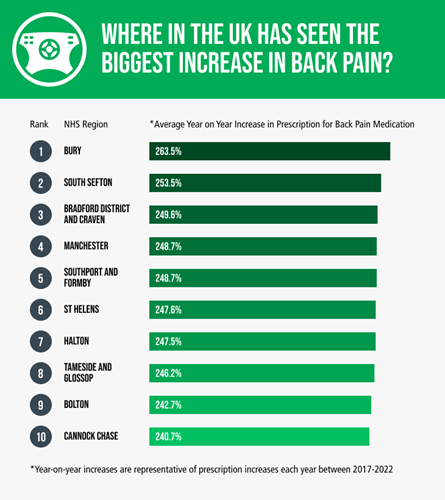UK Drivers and Back Pain Report
![]() 10/03/2023
10/03/2023![]() 8 minutes read
8 minutes read
UK Drivers & Back Pain Report
In the UK, eight million adults suffer from chronic back pain. This condition also currently stands as the largest single cause of disability across the country. In fact, according to NHS resources [1], lower back problems alone account for 11% of the total disability of the UK population and, alongside other musculoskeletal conditions, costs the NHS around £5 billion each year [2].
Driving has been deemed one of the leading causes of back aches for Brits, with a recent study finding that 75% of frequent drivers are experiencing this discomfort [3]. With an average of 750,000 new drivers in the UK each year, this is a health and economic issue that will inevitably be on the rise [4].
Looking at commercial driving habits, we analysed prescription data for leading back pain medications to explore where in the UK drivers are suffering the most. With back trouble also being one of the biggest causes of work absences, accounting for more than 12 million days lost every year, we have also examined how much these absences are costing UK businesses[5]. In response, we share some top tips on how business owners and fleet managers can work to reduce the chances of sick leave as a result of back-related injuries.
Where in the UK is suffering the most from back pain?
Our study explored prescription data for three anti-inflammatory medications typically prescribed for back pain: Diclofenac Diethyl, Salicylate, and Capsaicin. Prescription totals per 1,000 people were combined for each analysed NHS region, revealing where in the UK people are suffering the most from back aches.

Bolton, a town in Greater Manchester, has the highest proportion of people suffering from back pain in the UK. The prescription data shows that an average of 122.1 prescriptions are prescribed each year per 1,000 people. This is a staggering 177% higher than the UK average of 44 annual prescriptions per 1,000 people. Bolton has also seen the ninth largest year-on-year increase in relevant medication, with an average 243% increase each year since 2017.
The Southport and Formby region ranks second with 115.6 prescriptions each year per 1,000 people, 5% lower than Greater Manchester. Following closely other top UK regions suffering most from back aches are Oldham (111.9 prescriptions), Tameside and Glossop (92.9 prescriptions), and South Sefton (92.7 prescriptions) respectively ranking third, fourth, and fifth.
As demonstrated by the map above, there is a heavy concentration of Brits experiencing back pain in the North West of England, all of the top ten most affected areas falling in this region. This is further reflected by Bury (263%), South Sefton (253%), Manchester (249%) and Southport and Formby (249%) all seeing the top five largest year-on-year prescription increases since 2017, with the Northern city of Bradford seeing the third biggest increase of 250%.

The five areas where Brits are suffering the least from back pain predominantly, with the exception of Bath and North East Somerset, fall in the East of England. These include:
- Bath & North East Somerset - 1.9 prescriptions per 1,000 people
- Thurrock - 5.3 prescriptions per 1,000 people
- West Essex - 6 prescriptions per 1,000 people
- Ipswich and East Suffolk - 9.6 prescriptions per 1,000 people
- North East Lincolnshire - 9.8 prescriptions per 1,000 people
How are back injuries impacting UK businesses?
Back troubles are one of the biggest causes of work absences, accounting for more than 12 million days lost every year. According to a recent report, 480,000 workers in the UK suffer from work-related back pain, with an average of 16 days lost per case [6].
This is especially impacting those who drive for a living. A recent study found that over two-thirds of van drivers (70%) in the UK take time off for back pain [7]. With 4.1 million licensed van drivers in the UK, and a day's sickness costing a business £107.85, work leave as a result of back pain is costing commercial driving businesses nearly £4.9 billion each year [8].
How to avoid a back injury when driving
We spoke to Dr. Hana Patel, a UK based General Practitioner, to find out more about the relationship between driving and back pain and how drivers can work to lower their chances of injury:
“As a GP expert witness, I see many patients with driving-related back pain injuries. Our bodies are made for movement, and sitting in one position for a long time in the car means that we may not be focusing on our posture. Such a static position will inevitably lead to muscle aches and pains.
There are different types of back pain caused as a result of driving that will vary depending on your physiology and posture. Pain can be experienced all across your back, from your shoulders down your spine and into your buttocks. Men, women, and different age groups are impacted differently or are more susceptible to back pain caused by driving. Generally, the estimate is that around one-third of people will be affected by back pain during their adult life, and back pain generally affects women more than men due to pelvic structural differences.
Here are my top tips to reduce and prevent back pain and injury when driving:
- When driving long distances, make sure that you stop for a rest break to stretch and have a walk every few hours, to prevent a build-up of tension in your lower back.
- People often forget that when driving, their seats, mirrors, and steering wheel should be adjusted to suit their height, leg length, and range of neck movements, to help reduce strain on joints unnecessarily.
- Hot and cold compression can help if you are in pain, and if you are lucky enough to have a heated seat, I would recommend using this periodically during longer drives to help ease muscle tension.”
Conclusion
As demonstrated in this report, back pain is a widespread issue across the UK with a particular impact in the North Western part of the country. With an average year-on-year prescription increase of 217% across the UK, it is clear that back related injuries are on the rise.
In light of these rises, businesses should be working to ensure that their employees are not putting themselves at risk of developing back-related injuries, something that is even more imperative in sectors most at risk, like commercial van driving.
Methodology
- Northgate Vehicle Hire conducted a study exploring where in the UK is experiencing the most back pain
- Through analysing leading health and back pain sites, Northgate Vehicle Hire identified three prominent back pain medications prescribed in the UK: Diclofenac Diethyl, Salicylate, and Capsaicin
- In-house experts extracted prescription data for each medication from NHS Open Prescribing Data. Data included the total number of prescriptions across 106 NHS regions over a five-year period (2017-2022)
- The populations served in each NHS region were also extracted utilising a range of online sources
- The total number of prescriptions for each medication was combined to establish a total number of prescriptions between 2017-2022 for each region
- The total number of prescriptions was divided by the total population and multiplied by 1,000 to determine the regional prescriptions per 1,000
- This total number of prescriptions was divided by 5 to determine the annual average prescription per 1,000 people between 2017-2022
- NHS regions were ranked in accordance with the average annual prescriptions per 1,000 people






